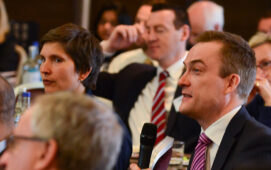This week I chatted to Shaun Brady, principal at not for profit advisory firm to the US government Mitre Corporation, about some of the work going on behind the scenes on Capitol Hill regarding the selection process for a technology provider and the finding of a suitable director to head up the Office of Financial Research (OFR). Given the slew of feedback the new Treasury agency has received this week in response to its legal entity ID proposals, which were published in the Fed Register in November, it is interesting to note that the position of director has still not been filled.
First a bit of background… Mitre has worked with various departments of the US government – the Department of Defence, the Federal Aviation Administration (FAA), the Internal Revenue Service (IRS), the Department of Veterans Affairs and the Department of Homeland Security – since it was first established back in 1958. To this end, it manages various government funded research and development centres to support the work of these particular departments and it also engages in ad hoc projects, hence its involvement in the developments surrounding the OFR.
Mitre employs acquisition and systems analysis experts to focus on a variety of tasks including: estimating cost and schedule resources for system development, production, operations, and maintenance of sponsors’ projects; developing acquisition strategies and assisting with source selection; performing cost, price, and technical analyses for contract negotiations; and performing financial analyses and identifying process reengineering opportunities.
In the case of the new Treasury agency, Brady explains that Mitre will be involved in helping to sort through the list of technical requirements from the feedback received from the industry. It will then likely assist in the evaluation process for the technology provider for the data collection agency underlying the OFR, the acquisition process and any related proof of concept work required. “We have completed some work around helping the US regulatory agencies to define their data collection requirements, with a view to keeping the burden on the industry as light as possible,” explains Brady.
Brady indicates that Mitre’s capabilities in data mining and collection, as well as its expertise in systems engineering and technology development have positioned it well to support this work. In fact, he refers to an earlier project Mitre was involved with to support the FAA’s data collection requirements for risk assessment of the airline industry and notes that a similar structure may be adopted for the OFR.
Mitre’s RiskNav tool has been designed to capture, analyse, and display risks at a project or enterprise level and is currently deployed throughout the intelligence community, at the Air Force’s Electronic Systems Centre and at the FAA. Given the goal of the OFR is to monitor systemic risk, such a model could certainly be up for consideration for this purpose.
Regarding Brady’s direct work in the data management space, he indicates that he was involved with Allan Mendelowitz’s Committee to Establish the National Institute of Finance (otherwise known as the precursor to the OFR) back in 2009. He has also been involved in the EDM Council’s proof of concept work around mortgage backed securities, which was tied to the development of a data utility in the US. The proof of concept work included unravelling the MBS process to identify essential data attribute and entity linkages and collecting instrument reference data from issuance documents based on a standard template using the EDM Council’s semantics repository. It also focused on mapping all relationships, defining IT architectural requirements, creating a database including APIs and messaging and mapping data into risk models to determine probability of default and loss given default.
As for the future of the OFR, Brady indicates that a lot is riding on the appointment of the right individual to head up the new agency. A lot of names have been “floated” over the last six months, none of who are particularly politically controversial, he explains. However, it will take an individual with the right level of drive and ambition to get the industry on board with the changes required. “A lot depends on how aggressively the director goes after the industry. If the right approach is not taken, it could kill the chances of the OFR,” warns Brady.
Given that the selection process has been much lengthier than first expected, due to a combination of factors including the current political and economic climate, this is also a potential concern. Unsurprisingly, those involved in the process, including president Obama, have other priorities on their agendas ahead of the OFR. Brady is confident, however, that an appointment will be made before July, as this is a key deadline for kicking off the standardisation process. At the moment, Lewis Alexander, a counsellor to Treasury Secretary Timothy Geithner, is heading the OFR on a temporary basis, until the appointment is made.
Brady also indicates that the OFR is likely to opt for an existing infrastructure provider to act as the data collection agency (the DTCC seems to be the name most often mentioned in this context) because of fact this would result in “less resistance from the industry” and incur fewer costs than setting up a new body. “The plan is not to reinvent the wheel in any sense,” he adds. However, the director will certainly have his or her work cut out to get all the necessary pieces into place by the end of 2013 deadline.
I have been very sceptical about the political climate and its impact on the OFR’s chances, but if the right appointment is made (and soon) then perhaps the future might look a little brighter…
Subscribe to our newsletter




